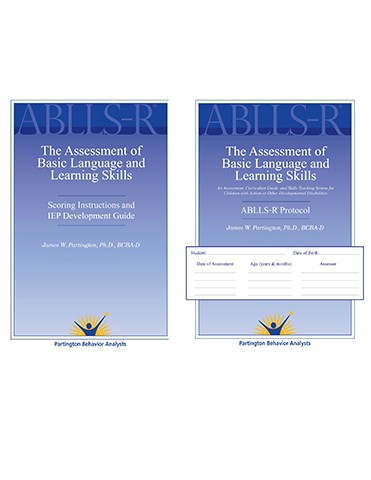The Assessment of Basic Language and Learning Skills – Revised (ABLLS-R®) is a vital tool developed by expert Dr. James W. Partington for educators, therapists, and parents of children with autism or other developmental delays. More than just an assessment, the ABLLS-R serves as a curriculum guide and skill-tracking system, designed to pinpoint and address crucial developmental needs. It stands as a practical, user-friendly resource that aids in understanding the specific skills a child requires to effectively communicate and learn from their daily interactions.
 ABLLS-R Protocol Cover
ABLLS-R Protocol Cover
Unpacking the ABLLS-R: What Does It Assess?
The ABLLS-R offers an exhaustive evaluation of 544 skills across 25 key areas. These encompass fundamental aspects of development, including language capabilities, social interaction skills, self-help abilities, academic readiness, and motor skills. It is structured to reflect the developmental milestones typically achieved by children before kindergarten entry. Within each skill area, tasks are ordered progressively, from simpler to more complex, allowing for a nuanced understanding of a child’s current abilities and developmental trajectory.
A significant feature of the ABLLS-R is its approach to expressive language assessment. Rooted in the principles of behavioral analysis of language as outlined by Dr. B.F. Skinner in “Verbal Behavior,” the assessment provides a deep dive into how children use language. By analyzing assessment results, professionals and parents can identify specific barriers hindering a child’s skill acquisition. This insight is crucial for designing targeted, language-based intervention strategies and individualized education programs.
What’s New in the Revised ABLLS-R?
The 2006 revised edition of the ABLLS, the ABLLS-R, brought significant enhancements to the original tool. It incorporates a wealth of new task items and refines the developmental sequence within skill areas, offering a more granular and precise assessment. Notable improvements were made to the vocal imitation section, incorporating insights from Denise Senick-Pirri, SLP-CCC. Furthermore, the ABLLS-R expanded its coverage of social interaction skills, motor imitation, and joint attention skills, ensuring a more holistic evaluation. These revisions also emphasize the importance of fluent application of learned skills, moving beyond simple acquisition to functional use.
Components of the ABLLS-R: Protocol and Guide
The ABLLS-R is provided as a set of two essential documents:
The ABLLS-R Protocol: This is the working document used to record a child’s performance across all assessed tasks. Crucially, it includes 15 appendices designed for tracking specific skills in detail. The Protocol features skill-tracking grids, enabling educators and parents to systematically monitor and document a child’s progress in acquiring essential skills over time.
The ABLLS-R Guide: This document serves as the comprehensive instruction manual for the ABLLS-R. It details the features of the assessment, provides clear guidelines on accurate scoring methods, and crucially, explains how to leverage assessment results to develop effective Individualized Education Program (IEP) goals and objectives. The Guide empowers users to translate assessment findings into actionable learning plans that directly address a student’s unique educational needs.
Who Benefits from the ABLLS-R?
The ABLLS-R set, including both the Guide and Protocol, is essential for anyone starting out with this assessment tool. While additional Protocols can be purchased separately for ongoing use, the initial purchase must be the complete set to ensure users have the necessary instructions and framework for proper implementation. This policy reflects the significant updates and refinements in the ABLLS-R, ensuring all users benefit from the most current and effective version. Whether you are a parent navigating the complexities of autism, an educator striving to create tailored learning experiences, or a therapist focused on language and skill development, the ABLLS-R provides a robust foundation for understanding and fostering a child’s potential.